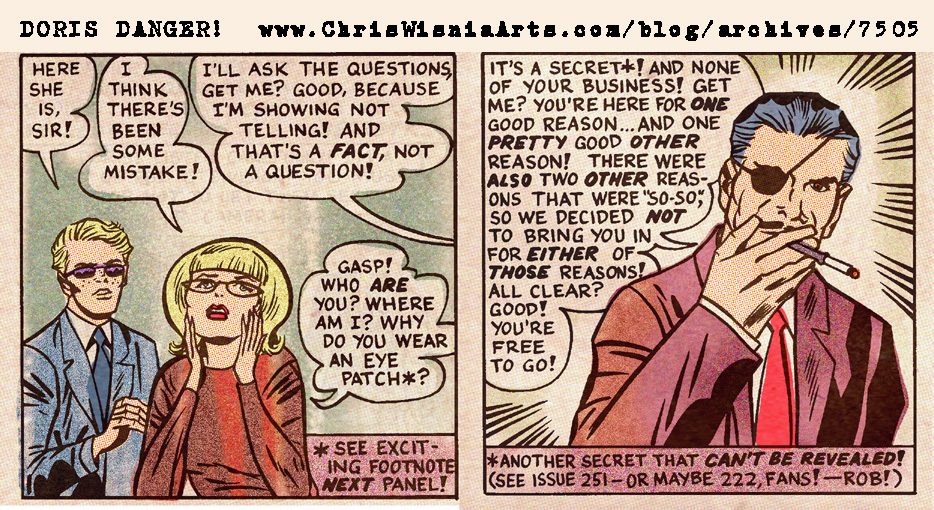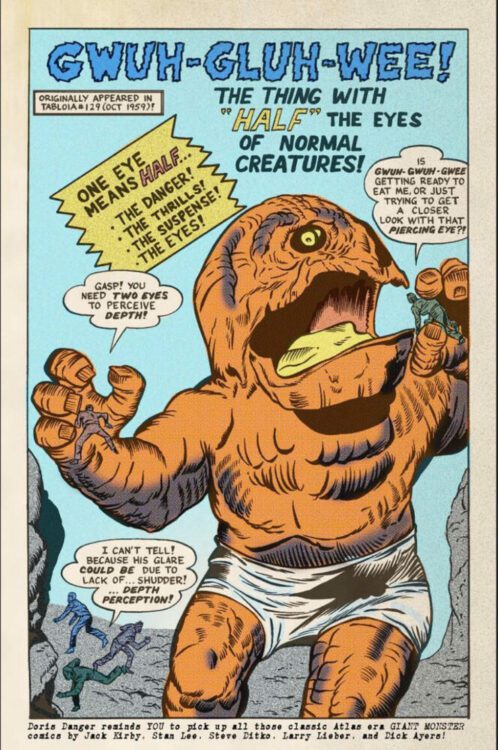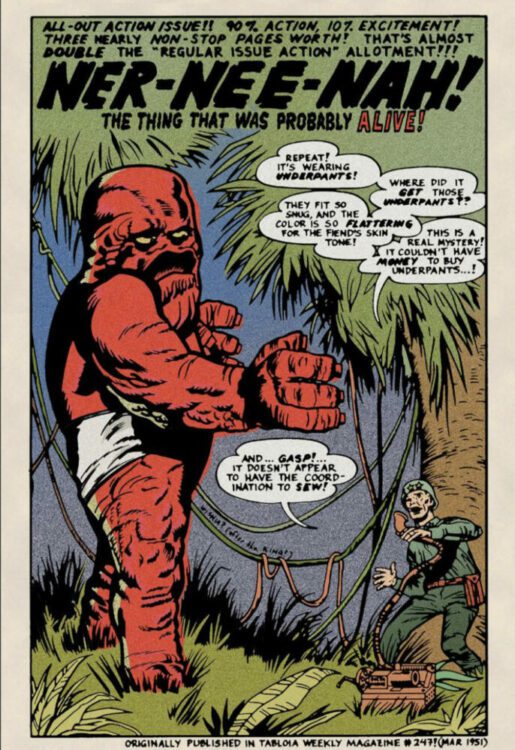Marvel wasn’t always a company associated with giving “real” problems to heroes in spandex. They started as a mere arm of Atlas comics, a company dedicated to chasing wider cultural trends with comics about cowboys, romance, war, and — eventually — monsters. Giant, wrinkly-faced monsters with silly names and oversized underpants. Those monsters were the last gasp of the Atlas era. The comic books that creators like Jack Kirby, Stan Lee, and Dick Ayers made together before creating the modern Marvel Universe. Writer/artist Chris Wisnia and colorist Ricky Sprague‘s Doris Danger: Giant Monsters Amok (out May 23 from Fantagraphics) is a glimpse into a world where those monster comics had the continuity of their superhero descendants. These disposable pulp publications have stitched together a nonsensical world even the historians in the book’s framing device can’t fully make sense of.

Doris Danger is presented as a collection of issues from the fictional Tabloia magazine. The introduction apologizes for the issues being printed out of order and poorly preserved, but gives an overview of the general plot as follows: Doris Danger is a photojournalist obsessed with finding proof of the existence of giant monsters. Standing in her way is the FBI’s “G” division, a government branch dedicated to hiding all evidence of monster attacks, all overseen by master financer Eugene Felk. Doris must continue her endless crusade for truth against whatever government cronies stand in her way.
MFR ON YOUTUBE (latest video)
Help us reach 5K Subs!
We can all agree that the Atlas monster comics were fairly silly, but Wisnia’s approach to parody in Doris Danger is much, much broader than just pointing out the absurdity of those comics. Read through a collection of the Atlas era, and what you’ll find are simple, stripped-down stories that have to use their short page counts as efficiently as possible. Character and plot beats get explained aloud, every panel carefully moving things forward. Wisnia uses similar 5-7 page counts, but for rambling, surreal arcs that gesture at some larger narrative that will never fully come. Characters spend entire pages expositing on past issues that never truly existed, or the importance of speaking in abbreviations. At one point, an entire page’s script is “accidentally” swapped with another. And whenever a character references a past issue, the numbering intentionally jumps all over the place. Events that take place alongside one another can be cited 100 issues apart, or even out of order.
This is all tied together by a framing device based around an “archivist” introducing the collection and trying to give context to why the pages are poorly reproduced or why the stories are out of order. It paints an (only slightly) exaggerated picture of the comic industry, each story heavily rushed and shoddily produced, the only remaining copies sourced from dead collectors or a kid who colored all his copies in. Romance comics are declared the “Golden Age,” where monster comics produced a month later are the “Silver Age.” It’s a mishmash of decades of comic history into a single, fictional series. Wisnia’s approach can be summed up by a sequence where a long, self-serious explanation of past issues is vandalized by a child’s crayon drawing. These old comics were powerful but silly, strikingly individual yet disposable. All penned by authors and artists fighting an uphill battle against an industry that didn’t value them.

Jack Kirby is the clearest artistic influence throughout Doris Danger, most stories drawn to intentionally mimic his style. There is the occasional romance issue that’s drawn in a clear Ditko homage, while Dick Ayers himself appears to guest-ink an issue. What works about the Kirby tribute are the ways in which Wisnia plays with classic Kirby-isms, like how many of the stories open on a dramatic splash page of a monster, only to have the creature barely factor into the story. Or how one page has a character strike some of Kirby’s favorite dynamic poses despite the fact they’re just having a mundane conversation.
As for the colors, Ricky Sprague shows great versatility in mimicking styles that bounce between decades. He especially does a great job in recreating the muted look of primary colors on thick newsprint. This can lead to jokes in itself, like when a character is introduced with Silver Age-style dramatic, orange lighting… only to reveal he actually is orange. The colors also create the issue of different print quality between issues, sometimes appearing smeared and off-register, or on one occasion, mocking the overbearing digital sheen of certain “remastered” classic comics. It’s a purposeful storytelling tool in itself, helping show the condition each issue was found in.

The lettering Wisnia uses mostly sticks to the rounded, all-caps style of classic Marvel, with a typewritten font acting as the voice of the archivist. The most fun is had with sound-effects, which are drawn as colorful balloon letters with exaggerated sounds like “Smoofy Smonch!” or “Ka-Booie-Ga-Booie-Ga!”
VERDICT
Doris Danger: Giant Monsters Amok sets its sights beyond just giant monsters. Marvel’s classic superhero stories, old romance comics, and the industry itself are all skewered under Wisnia’s pen. But what stood out the most about the book was its playfulness. From a foundation of stripped-down science fiction, Wisnia deforms and reshapes the familiar structure like clay. What would happen if a monster story just devolved into nothing but sound-effects? Or a story was just published as art-boards? It turns classic pulp into surreal collage. The book is out on May 24 from Fantagraphics, and you definitely want to get your hands on it.

